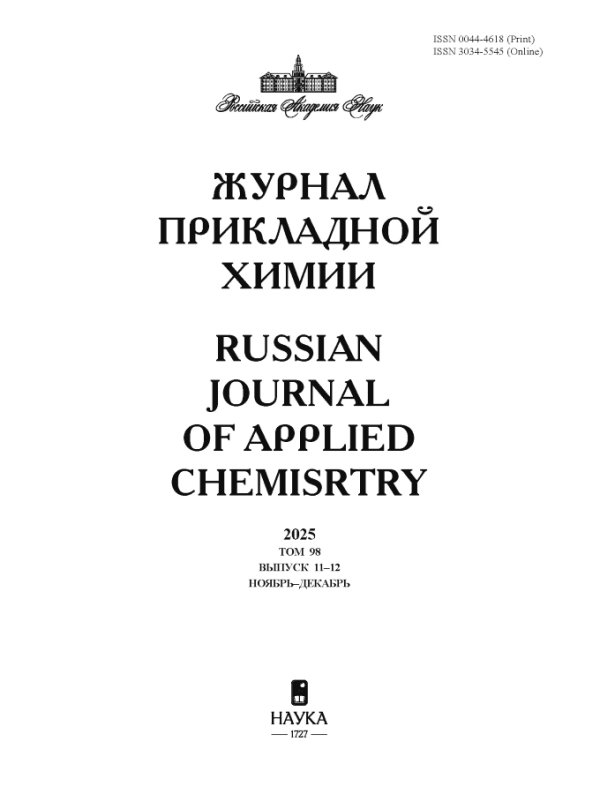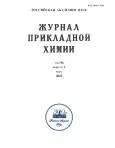Influence of the Moisture Content of Mesoporous Silica Gel on the Efficiency of the Chromatographic Recovery of Vanadyl Petroporphyrins with Benzene
- Authors: Mironov N.A.1, Tazeeva E.G.1, Milordov D.V.1, Yakubova S.G.1, Yakubov M.R.1
-
Affiliations:
- Arbuzov Institute of Organic and Physical Chemistry, Federal Research Center Kazan Scientific Center, Russian Academy of Sciences
- Issue: Vol 96, No 3 (2023)
- Pages: 305-315
- Section: Articles
- URL: https://journals.rcsi.science/0044-4618/article/view/247297
- DOI: https://doi.org/10.31857/S004446182303009X
- EDN: https://elibrary.ru/PIESFQ
- ID: 247297
Cite item
Full Text
Abstract
Benzene proved to be a more effective eluent compared to chlorinated organic solvents traditionally used for chromatographic recovery of vanadyl petroporphyrins from the dimethylformamide (DMF) extract of asphaltenes on a column packed with mesoporous silica gel. Low eluting power of benzene can be compensated by moistening of the silica gel adsorbent. An increase in the silica gel moisture content from 0 to 7.7% does not lead to a decrease in the efficiency of the separation of vanadyl porphyrins from nonporphyrin components but leads to a tenfold decrease in the eluent consumption. A decrease in the eluent flow rate from 0.8 to 0.12 mL min–1 (per gram of the adsorbent) leads to a 1.5-fold increase in the yield of vanadyl porphyrins of required purity. An increase in the adsorbate : adsorbent weight ratio from 1 : 833 to 1 : 83 does not lead to a decrease in the efficiency of the vanadyl porphyrin recovery. Elution with benzene under optimum conditions (adsorbent moisture content, eluent flow rate, adsorbate : adsorbent ratio) allows the recovery of 3 times larger amount of petroleum vanadyl porphyrins from the DMF extract of asphaltenes than when using chloroform and dried silica gel under equal other conditions.
About the authors
N. A. Mironov
Arbuzov Institute of Organic and Physical Chemistry, Federal Research Center Kazan Scientific Center, Russian Academy of Sciences
Email: acjournal.nauka.nw@yandex.ru
Kazan, 420088, Tatarstan, Russia
E. G. Tazeeva
Arbuzov Institute of Organic and Physical Chemistry, Federal Research Center Kazan Scientific Center, Russian Academy of Sciences
Email: acjournal.nauka.nw@yandex.ru
Kazan, 420088, Tatarstan, Russia
D. V. Milordov
Arbuzov Institute of Organic and Physical Chemistry, Federal Research Center Kazan Scientific Center, Russian Academy of Sciences
Email: acjournal.nauka.nw@yandex.ru
Kazan, 420088, Tatarstan, Russia
S. G. Yakubova
Arbuzov Institute of Organic and Physical Chemistry, Federal Research Center Kazan Scientific Center, Russian Academy of Sciences
Email: acjournal.nauka.nw@yandex.ru
Kazan, 420088, Tatarstan, Russia
M. R. Yakubov
Arbuzov Institute of Organic and Physical Chemistry, Federal Research Center Kazan Scientific Center, Russian Academy of Sciences
Author for correspondence.
Email: acjournal.nauka.nw@yandex.ru
Kazan, 420088, Tatarstan, Russia
References
- McKenna A. M., Chacón-Patiño M. L., Vallverdu G. S., Bouyssiere B., Giusti P., Afonso C., Shi Q., Combariza M. Y. Advances and challenges in the molecular characterization of petroporphyrins // Energy Fuels. 2021. V. 35. P. 18056-18077. https://doi.org/10.1021/acs.energyfuels.1c02002
- Zhao X., Xu C., Shi Q. Structure and modeling of complex petroleum mixtures. Structure and bonding / Eds C. Xu, Q. Shi. Cham, Switzerland: Springer Int. Publ., 2015. V. 168. P. 39-70. https://doi.org/10.1007/430_2015_189
- Woltering M., Tulipani S., Boreham C. J., Walshe J., Schwark L., Grice K. Simultaneous quantitative analysis of Ni, VO, Cu, Zn and Mn geoporphyrins by liquid chromatography-high resolution multistage mass spectrometry: Method development and validation // Chem. Geol. 2016. V. 441. P. 81-91. https://doi.org/10.1016/j.chemgeo.2016.08.005
- Zheng F., Hsu C. S., Zhang Y., Sun Y., Wu Y., Lu H., Sun X., Shi Q. Simultaneous detection of vanadyl, nickel, iron, and gallium porphyrins in marine shales from the Eagle Ford formation, South Texas // Energy Fuels. 2018. V. 32. N 10. P. 10382-10390. https://doi.org/10.1021/acs.energyfuels.8b01728
- Rytting B. M., Singh I. D., Kilpatrick P. K., Harper M. R., Mennito A. S., Zhang Y. Ultrahigh-purity vanadyl petroporphyrins // Energy Fuels. 2018. V. 32. P. 5711-5724. https://doi.org/10.1021/acs.energyfuels.7b03358
- Mironov N. A., Abilova G. R., Borisova Y. Y., Tazeeva E. G., Milordov D. V., Yakubova S. G., Yakubov M. R.Comparative study of resins and asphaltenes of heavy oils as sources for obtaining pure vanadyl porphyrins by the sulfocationite-based chromatographic method // Energy Fuels. 2018. V. 32. P. 12435-12446. https://doi.org/10.1021/acs.energyfuels.8b03411
- Mironov N., Milordov D., Abilova G., Tazeeva E., Yakubova S., Yakubov M. Preparative-scale purification of petroleum vanadyl porphyrins by sulfuric acid loaded macroporous silica //j. Porphyrins Phthalocyanines. 2020. V. 24. P. 528-537. https://doi.org/10.1142/S1088424619501979
- Миронов Н. А., Тазеева Э. Г., Милордов Д. В., Абилова Г. Р., Тазеев Д. И., Якубова С. Г., Якубов М. Р. Адсорбционно-экстрографическое концентрирование нефтяных ванадилпорфиринов из N,N-диметилформамидного экстракта асфальтенов тяжелой нефти // ЖПХ. 2021. Т. 94. № 9. С. 1214-1224. https://doi.org/10.31857/S0044461821090115
- Chen Q., Gray M. R., Liu Q. Irreversible adsorption of asphaltenes on kaolinite: Influence of dehydroxylation // Energy Fuels. 2017. V. 31. N 9. P. 9328-9336. https://doi.org/10.1021/acs.energyfuels.7b01844
- Cortés F. B., Montoya T., Acevedo S., Nassar N. N., Franco C. A. Adsorption-desorption of n-C7 asphaltenes over micro- and nanoparticles of silica and its impact on wettability alteration // CT&F - Ciencia, Tecnologia y Futuro. 2016. V. 6. N 4. P. 89- 106. https://doi.org/10.29047/01225383.06
- Pradilla D., Subramanian S., Simon S., Sjöblom J., Beurroies I., Denoyel R. Microcalorimetry study of the adsorption of asphaltenes and asphaltene model compounds at the liquid-solid surface // Langmuir. 2016. V. 32. N 29. P. 7294-7305. https://doi.org/10.1021/acs.langmuir.6b00816
- Hu X., Yutkin M. P., Hassan S., Wu J., Prausnitz J. M., Radke C. J. Asphaltene adsorption from toluene onto silica through thin water layers // Langmuir. 2019. V. 35. N 2. P. 428-434. https://doi.org/10.1021/acs.langmuir.8b03835
- Cantú R., Stencel J. R., Czernuszewicz R. S., Jaffé P. R., Lash T. D. Surfactant-enhanced partitioning of nickel and vanadyl deoxophylloerythroetioporphyrins from crude oil into water and their analysis using surface- enhanced resonance Raman spectroscopy // Environ. Sci. Technol. 2000. V. 34. N 1. P. 192-198. https://doi.org/10.1021/es990213s
- Foster N. S., Day J. W., Filby R. H., Alford A., Rogers D. The role of Na-montmorillonite in the evolution of copper, nickel, and vanadyl geoporphyrins during diagenesis // Org. Geochem. 2002. V. 33. N 8. P. 907-919. https://doi.org/10.1016/S0146-6380(02)00065-7
- Mironov N., Milordov D., Tazeeva E., Tazeev D., Abilova G., Yakubova S., Yakubov M. Impact of asphaltenes on the adsorption behavior of petroleum vanadyl porphyrins: Kinetic and thermodynamic aspects //Energy Fuels. 2021. V. 35. P. 14527-14541. https://doi.org/10.1021/acs.energyfuels.1c01495
Supplementary files










